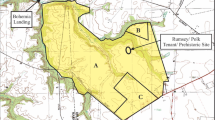Abstract
Studies of Charleston, South Carolina, architecture and archaeology tend to focus on the artifacts and landscapes of the city’s white populace. This essay builds on the growing wealth of archaeologically recovered African-American material culture and initiates a discussion on Charleston’s slave quarters and their settings.
Similar content being viewed by others
References
Barnwell, Joseph W. (editor) 1912 Dairy of Timothy Ford, 1785–1786. TheSouth Carolina Historical and Genealogical Magazine 13:3.
Chalmers, Lionel. 1790 A Sketch of the Climate, Water, and Soil in South Carolina. In The American Museum or Repository of Ancient and Modern Fugitive Pieces, &c. Prose and Poetical, For April, 1788. Carey, Stewart, & Co., Philadelphia, PA.
Charleston County Probate Court (CCPC) 1775 Inventory of John Ingliss. Inventory Book A, pp. 452, Charleston County Probate Court, Charleston, SC.
1786 Inventory of Martha Godin. Inventory Book B, pp. 2–3, Charleston County Probate Court, Charleston, SC.
1791 Inventory of Alexander Ingliss. Inventory Book B, pp. 369, Charleston County Probate Court, Charleston, SC.
1811 Inventory of Matthew William Cross. Inventory Book E, pp 43, Charleston County Probate Court, Charleston, SC.
1815 Inventory of Francis Simmond. Inventory Book E, pp 259, Charleston County Probate Court, Charleston, SC.
Charleston County Register Mesne Conveyance Office (RMCO) 1797 Plat of Edward Petrie’s property. McCrady Plat No. 464, Charleston County Register Mesne Conveyance Office, Charleston, SC.
1798 Plat of King Street. McCrady Plat No. 178, Charleston County Register Mesne Conveyance Office, Charleston, SC.
1799 Plat of a property on Blackbird Alley. McCrady Plat No. 536, Charleston County Register Mesne Conveyance Office, Charleston, SC.
1790s-a Plat of King Street. McCrady Plat No. 172, Charleston County Register Mesne Conveyance Office, Charleston, SC.
1790s-b Plat of Union Street. McCrady Plat No. 562, Charleston County Register Mesne Conveyance Office, Charleston, SC.
1837 Plat of Broad Street. McCrady Plat No. 485, Charleston County Register Mesne Conveyance Office, Charleston, SC.
1800s-a Plat of Broad Street. McCrady Plat No. 557, Charleston County Register Mesne Conveyance Office, Charleston, SC.
1800s-b Charleston County Deed Book X-6. Charleston County Register Mesne Conveyance Office, Charleston, SC.
Horlbeck Brothers Daybook 1849 Account records of the Horlbeck Brothers. South Carolina Historical Society, Charleston.
Pearson, Edward A. 1998 Designs Against Charleston: The Trial Transcript of the Denmark Vesey Conspiracy of 1822. University of North Carolina Press, Chapel Hill.
Stoney, Samuel Gaillard 1987 This is Charleston: A Survey of the Architectural Heritage of a Unique American City. Carolina Art Association, Charleston, SC.
Upton, Dell. 1988 White and Black Landscapes in Eighteenth-Century Virginia. In Material Life in Early America 1600–1860, Robert Blair St. George, editor, pp. 357–369. Northeastern University Press, Boston, MA.
Wade, Richard C. 1964 Slavery in the Cities: The South 1820–1860. Oxford University Press, Oxford, England.
Author information
Authors and Affiliations
Rights and permissions
About this article
Cite this article
Herman, B.L. Slave and servant housing in Charleston, 1770–1820. Hist Arch 33, 88–101 (1999). https://doi.org/10.1007/BF03373625
Published:
Issue Date:
DOI: https://doi.org/10.1007/BF03373625




